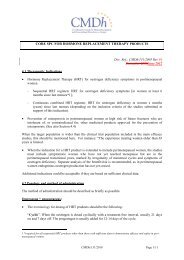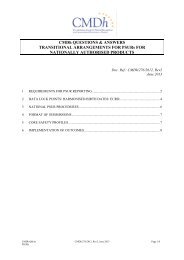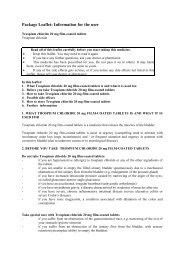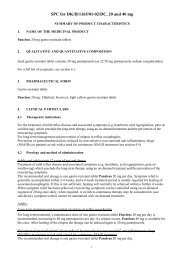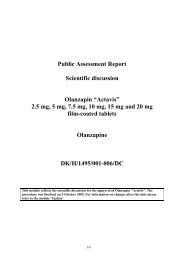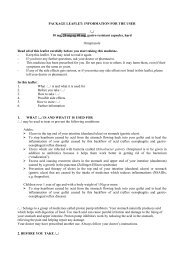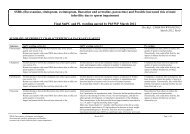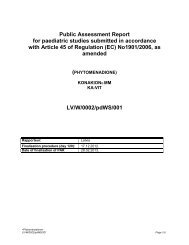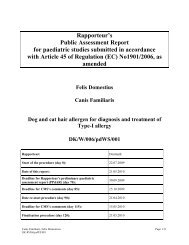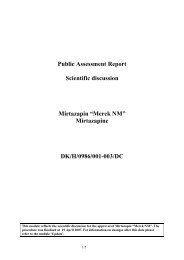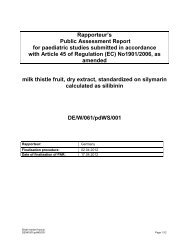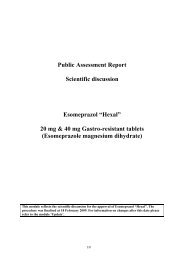Public Assessment Report for paediatric studies submitted in ...
Public Assessment Report for paediatric studies submitted in ...
Public Assessment Report for paediatric studies submitted in ...
You also want an ePaper? Increase the reach of your titles
YUMPU automatically turns print PDFs into web optimized ePapers that Google loves.
Six and 7 subjects reported an <strong>in</strong>crease <strong>in</strong> glucose values <strong>in</strong> the VENTOLIN HFA 180mcg and<br />
360mcg groups respectively. None of these glucose values were considered cl<strong>in</strong>ically significant by the<br />
respective study <strong>in</strong>vestigators.<br />
Symptoms of Adrenergic Stimulation:<br />
At the end of treatment (which occurred at assessment 10 or premature discont<strong>in</strong>uation) the heart<br />
rate decreased <strong>for</strong> both treatments and the decrease ranged between -9.6 and -1.8 bpm.<br />
Symptoms of adrenergic stimulation<br />
Five subjects <strong>in</strong> the VENTOLIN HFA 180mcg and 9 subjects <strong>in</strong> the VENTOLIN HFA 360mcg<br />
group had at least one post-basel<strong>in</strong>e pulse rate of ≥20% over basel<strong>in</strong>e. One subject each (#102 and 159)<br />
<strong>in</strong> both the treatment groups had this <strong>in</strong>crease at 0 m<strong>in</strong> pre-dose there<strong>for</strong>e a basel<strong>in</strong>e condition. Two<br />
subjects <strong>in</strong> the VENTOLIN HFA 180mcg (#311 and 451) group and 4 subjects <strong>in</strong> the VENTOLIN HFA<br />
360mcg (#102, 426, 453, 459) group were either agitated or cry<strong>in</strong>g dur<strong>in</strong>g the procedure. For the other<br />
subjects the respective study site <strong>in</strong>vestigator did not consider the <strong>in</strong>crease <strong>in</strong> pulse rates to be significant.<br />
None of the subjects with a HR <strong>in</strong>crease of >20% over basel<strong>in</strong>e were considered by the<br />
respective <strong>in</strong>vestigator as significant to be recorded as an AE.<br />
The overall <strong>in</strong>cidence of AEs possibly related to adrenergic stimulation was very low and<br />
occurred <strong>in</strong> a s<strong>in</strong>gle subject each <strong>in</strong> the VENTOLIN HFA 180mcg (ventricular extrasystole) and 360mcg<br />
(tachycardia) groups. The subject (#385) presented with this condition <strong>in</strong> an ECG prior to the<br />
adm<strong>in</strong>istration of <strong>in</strong>vestigational product. Both these subjects had with<strong>in</strong> threshold values <strong>for</strong> serum<br />
potassium <strong>for</strong> both screen<strong>in</strong>g and end of treatment visits. These AEs resolved the same day and did not<br />
lead to subject withdrawal from the study.<br />
Pulse oxymetrie<br />
Pulse oximetry at the beg<strong>in</strong> of the study was greater than 88%, but the end of study the mean<br />
basel<strong>in</strong>e pulse oximetry values were <strong>in</strong>creased and were comparable between the two treatments (94.9%<br />
(SD=2.84) <strong>for</strong> VENTOLIN HFA 180mcg group and 95.7% (SD=3.01) <strong>for</strong> VENTOLIN HFA 360mcg<br />
group).<br />
Assessor's comment:<br />
The results obta<strong>in</strong>ed from this study showed that treatment with salbutamol <strong>in</strong>halation aerosol decreased<br />
percentage and also the absolute values of Modified Tal Asthma Symptoms Score from basel<strong>in</strong>e. The mean<br />
dose <strong>for</strong> rescue albuterol use dur<strong>in</strong>g treatment was considerably higher <strong>in</strong> the VENTOLIN HFA 360 mcg<br />
group (1340mcg) when compared to the VENTOLIN HFA 180mcg group (288mcg) was very similar <strong>for</strong><br />
both groups.<br />
However, <strong>in</strong> terms of effectiveness , no significant differences have been found between the two treatment<br />
doses (VENTOLIN HFA 180mcg and VENTOLIN HFA 360 mcg, respectively) adm<strong>in</strong>istered.<br />
The current study conducted <strong>in</strong> children younger than 24 months old and adm<strong>in</strong>istered cumulative doses<br />
of VENTOLIN HFA MDI 180mcg or 360mcg with valved hold<strong>in</strong>g chamber and attached facemask<br />
demonstrated that it has been well tolerated by this population. The safety profile of VENTOLIN HFA<br />
180mcg and VENTOLIN HFA 360 mcg was similar compared to placebo. Significant adverse effects such<br />
as hypokalemia, <strong>in</strong>creased heart rate, adrenergic stimulation or abnormalities <strong>in</strong> heart rate or QT<br />
prolongation difference were not between the two treatment groups.<br />
Assessor’s discussion and conclusion<br />
Ventol<strong>in</strong> <strong>in</strong>haled <strong>for</strong>mulations is registered <strong>for</strong> use <strong>in</strong> adult and children of all ages <strong>for</strong> the asthma<br />
treatment. There is no lower age range limit established by GlaxoSmithKl<strong>in</strong>e <strong>for</strong> Ventol<strong>in</strong> <strong>in</strong>haled<br />
<strong>for</strong>mulations.<br />
Salbutamol F<strong>in</strong>al <strong>Public</strong> <strong>Assessment</strong> <strong>Report</strong><br />
RO/W/0001/pdWS/001<br />
Page 36/76



